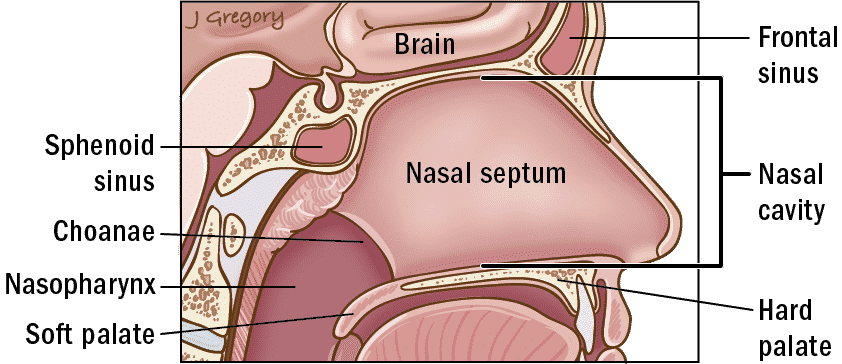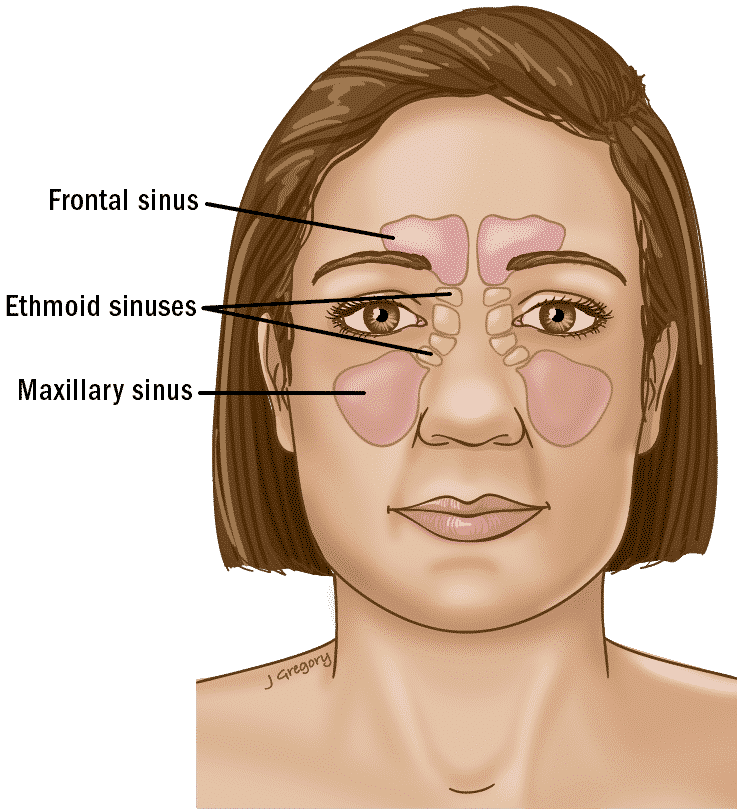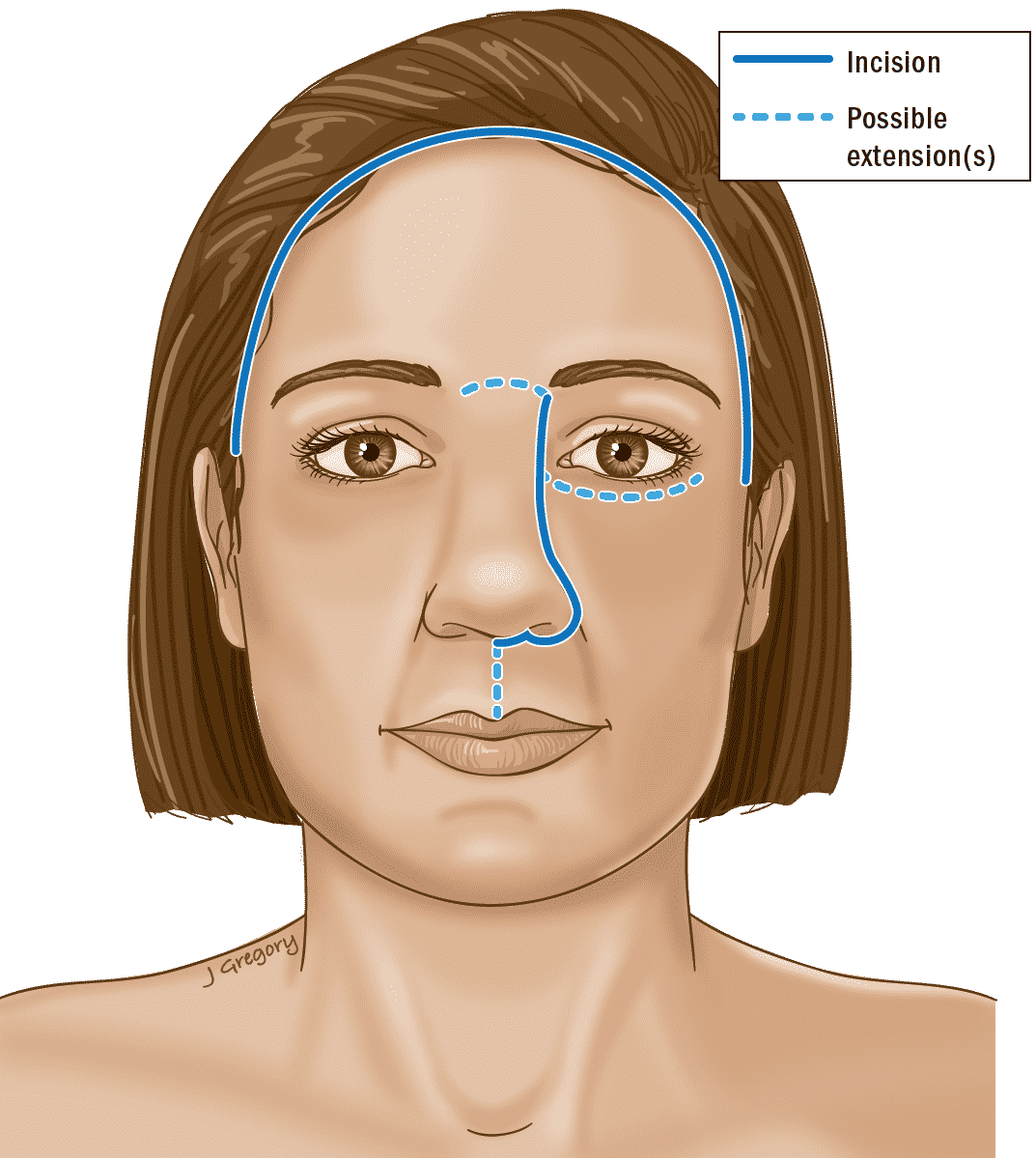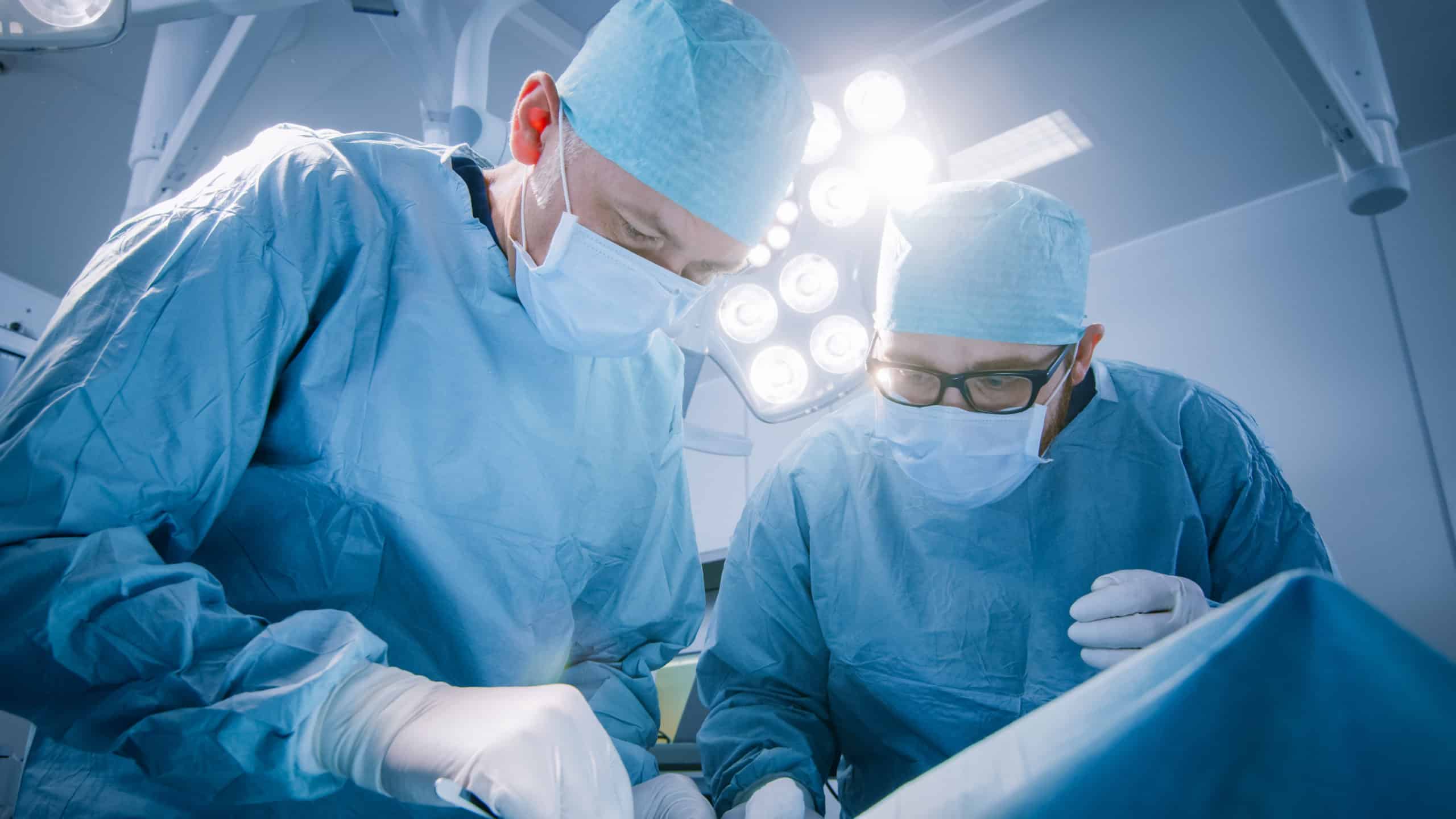The craniofacial area refers to the bones of the skull and the face. Craniofacial resection is the surgical removal of tumors in these regions. This procedure involves making incisions in the scalp, the interior of the nose, and sometimes on the face to access the tumor. Your surgeon approaches the tumor strategically to reduce the risk of damage to the brain, nerves, or other major structures. You will be put to sleep under general anesthesia during this procedure.
A craniofacial resection involves removing the tumor via incisions in the scalp, within the nose, and sometimes on the face to gain access to tumors that involve or approach the overlapping area between the face and the floor of the cranial cavity (called the skull base).


By approaching the tumor from above and below, surgeons have a better chance to confidently remove all of the tumor while decreasing possible damage to the brain, nerves and other major structures. This procedure is usually performed with the assistance of a neurosurgeon.
Preparing for Surgery (Pre-Surgery)
You will receive specific instructions from your physician for how to appropriately prepare for the procedure, such as when to arrive and food/drink restrictions. On the day of your surgery, you will arrive at the hospital a few hours before your scheduled procedure. The nurses, anesthesiologist, and neurosurgery and head and neck surgery teams will check in with you. If you have any last minute questions, this is a good time to ask them.
What to Expect from the Surgery
As mentioned previously, general anesthesia will be used to put you to sleep during the surgery. Multiple approaches exist for craniofacial resection depending on the location, size, and extent of the tumor.

Lateral Rhinotomy Approach
Accesses tumors in the anterior skull base and sinuses in the upper part of the nose.
Weber Ferguson Approach
Accesses tumors involving the upper jaw (maxilla) and eye socket (orbit).
This operation requires a neurosurgeon to work alongside a head and neck surgeon to completely remove the tumor. Certain resection and reconstruction approaches may require a tracheostomy and/or feeding tube to help you breathe and eat. The resected tumor will be sent to the frozen section lab to be analyzed by a pathologist. The frozen section analysis allows for immediate assessment of the tumor during surgery. Once the pathologist determines that the operable tumor has been removed sufficiently, the reconstruction process will begin. The skull base needs to be reconstructed in several layers in order to prevent the bacteria in the nasal cavity from entering the brain.
Specific Risks Associated with Craniofacial Surgery
- Infection
- Bleeding, including hematoma
- Increased air around the brain (Pneumocephalus)
- Cerebrospinal fluid leak
- Imbalance of water and sodium metabolism (Diabetes insipidus)
- Loss of smell
- Facial nerve injury
- Chronic tearing problems
- Vision changes
- Facial numbness
- Mucus retention
Top Questions for Your Doctor
Access our list of the most important questions to ask your physician at your next appointment.
Post Surgery Recovery & Aftercare
Overview: Depending on the extent of surgery, a hospital admission may be required after surgery, including monitoring in the intensive care unit (ICU) for some patients. The duration of time spent in the hospital post-surgery is case-dependent. A discharge planning team will work with you and your family to determine the best route forward.
The recovery course will depend on the extent of the surgery and reconstruction. Following a craniofacial resection, the patient will go to an intensive care unit (ICU) for close monitoring. The patient will be monitored for neurological function, blood sodium levels, urine output and other factors. If a free flap was done, that will also be monitored very closely to make certain that the blood flow to the flap remains intact after surgery. Patients will eventually be transitioned from the ICU to the regular hospital floor.
Once doctors determine that a patient no longer needs in-patient level care, they will be ready for discharge. The length of hospital stay depends on the extent of the operation, but is usually between 5-8 days. While some patients can go home from the hospital with or without visiting nurses or receiving home care, others might go to a rehabilitation or skilled nursing facility for a short while before going home. The discharge planning team, which includes doctors, social workers, nurses and physical therapists, along with the patient and their family, will determine the best place for the patient to go once they’re ready to leave the hospital.
Any additional treatment is planned after discharge. This gives the patient time to recover from the initial surgery, get the final pathology results of the surgery, and make appropriate arrangements for next steps.

Download This Section
Feel free to download and print this page.
It’s free for personal use and to share with others you think might benefit from the information provided.
Risks
Both the neurosurgical and head and neck components of the surgery carry associated risks.
- Infection
The overall risk of infection is low but can be very serious for craniofacial resections. Antibiotics are administered prior to the surgery and at regular intervals during and after the surgery. Infection in this area can lead to major problems, including meningitis, epidural abscess, or brain abscess. These must be treated quickly and efficiently and may require surgical drainage. - Bleeding (including Hematoma)
If there is severe bleeding after the procedure, the surgeon might need to quickly take the patient back to the operating room to stop the bleeding. - Pneumocephalus
This is air in the area around the brain. If this keeps getting bigger, it could compress parts of the brain and cause major problems. If there is a sudden and noticeable change in a patient’s mental status, doctors might order an urgent CT scan to see what’s going on inside their head. A small amount of pneumocephalus can be normal after surgery and will resolve without any treatment. - CSF Leak
This is a leak of cerebrospinal fluid down into the nose, and means that the covering layer of the floor of the brain is not watertight. If fluid is leaking into the nose, the bacteria from the nose could migrate toward the brain and cause infection. Antibiotics are typically required. CSF leaks can sometimes stop with conservative treatment, such as bed rest or lumbar drain placement. However, larger leaks may require returning to the operating room and revision of the skull base reconstruction. - Diabetes Insipidus
This is the result of a water and sodium imbalance in the body that may occur following neurosurgical procedures. Blood sodium levels, urine output and urine electrolytes will be measured to monitor for this. - Loss of Smell
The nerves for smell are located in the middle part of the anterior skull base, just above the nose. If this area needs to be resected, a patient will likely lose their sense of smell. - Facial Nerve Injury
When a coronal incision is made, the upper division of the facial nerve may be at risk of damage. The facial nerve controls the muscles of facial expression, so damage to this nerve would make it difficult for the patient to raise their forehead or to control the closure of the upper eyelid. This is usually temporary and only very rarely permanent if the nerve is cut. - Tearing (also called Epiphora)
Normally, tears empty into the nose through a small duct (nasolacrimal duct) from the corner of the eye next to the nose. If damage to the nasolacrimal duct occurs during tumor resection, a patient might have chronic tearing problems. This can be prevented by either placing tubes into the nasolacrimal duct that empties into the nose or by performing a dacryocystorhinostomy (DCR), which is the creation of a new opening in the nose to empty the duct and thereby providing a passage for the tears into the nose. - Vision Changes
Even in cases where the eye does not need to be removed, surgery close to the eye can lead to complications. For example, bleeding into the eye socket, if not recognized quickly, can lead to permanent blindness. Even if blindness does not occur, double vision (diplopia) can be a complication of this surgery as well. - Facial Numbness
Numbness of the upper part of the face can be caused by damage to the supraorbital or infraorbital nerve that runs just above the eye. The mid-face can be affected if the nerve under the eye is injured. - Mucocele
If part of the frontal sinus (one of the four pairs of paranasal sinuses that are situated behind the brow ridge) is removed and there is scarring of the duct that empties this sinus, the frontal sinus can fill with mucus that is unable to drain (called a mucocele). This is usually found during routine imaging months after surgery, or can eventually manifest symptoms of sinus pain, pressure, or headache.











